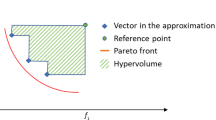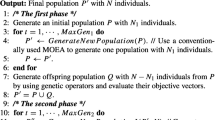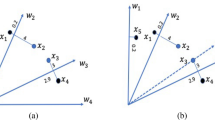Abstract
The effect of power-law fitness scaling method on the convergence and distribution of MOEAs is investigated in a systematic fashion. The proposed method is named as gamma (γ) correction-based fitness scaling (GCFS). What scaling does is that the selection pressure of a population can be efficiently regulated. Hence, fit and unfit individuals may be separated well in fitness-wise before going to the selection mechanism. It is then applied to Strength Pareto Evolutionary Algorithm 2 (SPEA2) and Domination Power of an individual Genetic Algorithm (DOPGA). Firstly, the effectiveness of GCFS is tested by 11 static gamma values (including 0.5, 1, 2, …, 9, 10) on nine well-known benchmarks. Simulated study safely states that SPEA2 and DOPGA may perform generally better with the square (γ = 2) and the cubic (γ = 3) of original fitness value, respectively. Secondly, an adaptive version of GCFS is proposed based on statistical merits (standard deviation and mean of fitness values) and implemented to the selected MOEAs. Generally speaking, fitness scaling significantly improves the convergence properties of MOEAs without extra computational burdens. It is observed that the convergence ability of existing MOEAs with fitness scaling (static or adaptive) can be improved. Simulated results also show that GCFS is only effective when fitness proportional selection methods (such as stochastic universal sampling—SUS) are used. GCFS is not effective when tournament selection is used.








Similar content being viewed by others
References
Coello CAC (1999) A comprehensive survey of evolutionary-based multiobjective optimization techniques. Knowl Inf Syst 1(3):269–308
Coello CAC, Lamont GB, Veldhuizen DA (2007) Evolutionary algorithms for solving multi-objective problems, 2nd edn. Springer, New York
Deb K (2001) Multiobjective optimization using evolutionary algorithms. Wiley, Chichester
Deb K, Pratap A, Agarwal S, Meyarivan T (2002) A fast and elitist multi-objective genetic algorithm: NSGA-II. IEEE Trans Evol Comput 6:182–197
Dorigo M, Stutzle T (2004) Ant colony optimization. MIT Press, Cambridge
Eberhart R, Kennedy J (1995) Particle swarm optimization. In: Proceedings of the IEEE international conference on neural networks, vol 4, pp 1942–1948
Ergul EU, Eminoglu I (2014) DOPGA: a new fitness assignment scheme for multi-objective evolutionary algorithms. Int J Syst Sci 45(3):407–426
Fonseca CM, Fleming PJ (1993) Genetic algorithms for multi-objective optimization: formulation, discussion and generalization. In: Proceedings of the fifth international conference on genetic algorithms, pp 416–423
Gandomi AH, Alavi AH (2012) Krill herd: a new bio-inspired optimization algorithm. Commun Nonlinear Sci Numer Simul 17(2):4831–4845
Gen M, Liu B, Ida K (1996) Evolution program for deterministic and stochastic optimizations. Eur J Oper Res 94(3):618–625
Ghosh A, Dehuri S (2005) Evolutionary algorithms for multi-criterion optimization: a survey. Int J Comput Inf Sci 2(1):38
Gillies AM (1985) Machine learning procedures for generating image domain feature detectors. Dissertation, University of Michigan, Ann Arbor
Goldberg DE (1989) Genetic algorithms in search, optimization and machine learning. Addison-Wesley Pub, Reading
Gonzales RC, Woods RE (2008) Digital image processing, 3rd edn. Pearson Prentice Hall, Englewood Cliffs
Hao GS, Chen YY, Wei KX, Gong G, Hu XT (2010) Parameter selection of fitness scaling in genetic algorithm and its application. In: Control and decision conference (CDCC 2010), pp 2475–2480
Hao GS, Lim MH, Ong YS, Huang H, Wang GG (2019) Domination landscape in evolutionary algorithms and its applications. Soft Comput 23:3563. https://doi.org/10.1007/s00500-018-3206-x
Hill S, Newell J, O’Riordan C (2004) Analysing the effects of combining fitness scaling and inversion in genetic algorithms. In: Proceedings of the 16th IEEE international conference on tools with artificial intelligence (ICTAI 2014), pp 380–387
Holland J (1975) Adaptation in natural and artificial systems. University of Michigan Press, Ann Arbor
Hopfield JJ (1982) Neural networks and physical systems with emergent collective computational abilities. Proc Natl Acad Sci 79:2554–2558
Hopgood AA (2001) Intelligent systems for engineers and scientists, 2nd edn. CRC Press, Boca Raton
Hopgood AA, Mierzejewska A (2009) Transform ranking: a new method of fitness scaling in genetic algorithms. In: Bramer M, Petridis M, Coenen F (eds) Research and development in intelligent systems XXV. SGAI 2008. Springer, London
Karaboga D, Basturk B (2007) A powerful and efficient algorithm for numerical function optimization: artificial bee colony (ABC) algorithm. J Global Optim 39(3):459–471
Kirkpatrick S, Gelatt CD, Vecchi MP (1983) Optimization by simulated annealing. Science 220(4598):671–680
Kreinovich V, Quintana C, Fuentes O (1993) Genetic algorithms: what fitness scaling is optimal? Cybern Syst 24:9–26
Leclerc F, Potvin JY (1995) A fitness scaling method based on a span measure. In: IEEE international conference on evolutionary algorithms, vol 2, pp 561–565
Michalewicz Z (1994) Genetic algorithms + data structures = evolution programs. Springer-Verlag, New York
Sadjadi F (2004) Comparison of fitness scaling functions in genetic algorithms with applications to optical processing. In: Javidi B, Psaltis D (eds), Optical information systems II, proceedings of SPIE, 5557, pp 356–364
Storn R, Price K (1997) Differential evolution–a simple and efficient heuristic for global optimization over continuous spaces. J Global Optim 11(4):341–359
Surajudeen-Bakinde NT, Zhu X, Gao J, Nandi AK (2009) Effects of fitness scaling and adaptive parameters on genetic algorithm based equalization for DS-UWB systems. In: International conference on computers and devices for communication, pp 1–4
Wang GG, Tan Y (2017) Improving metaheuristic algorithms with information feedback models. IEEE Trans Cybern 99:1–14
Wang GG, Guo L, Gandomi AH, Hao G-S, Wang H (2014a) Chaotic krill herd algorithm. Inf Sci 274:17–34
Wang GG, Gandomi AH, Alavi AH (2014b) Stud krill herd algorithm. Neurocomputing 128:363–370
Wang GG, Deb S, Coelho LDS (2015) Earthworm optimization algorithm: a bio-inspired metaheuristic algorithm for global optimization problems. Int J Bio-Inspired Comput 7:1–23
Wang GG, Gandomi AH, Zhao X, Chu HE (2016) Hybridizing harmony search algorithm with cuckoo search for global numerical optimization. Soft Comput 20(1):273–285
Wang GG, Deb S, Gao X-Z, Coelho LDS (2017) A new metaheuristic optimisation algorithm motivated by elephant herding behaviour. Int. J. Bio Inspired Comput. 8(6):394–409
Yang X-S, Deb S (2009) Cuckoo search via Lévy flights. In: Proceedings of world congress nature and biologically inspired computing (NaBIC), Coimbatore, India, pp 210–214
Zhang Q, Liu W, Li H (2009) The performance of a new version of MOEA/D on CEC09 unconstrained MOP test instances. In: CEC’09 Proceedings of the eleventh conference on congress on evolutionary computation, pp 203–208
Zitzler E (1999) Evolutionary algorithms for multiobjective optimization: methods and applications. Dissertation, Swiss Federal Institute of Technology, Switzerland
Zitzler E, Thiele L (1999) Multiobjective evolutionary algorithms: a comparative case study and the strength pareto approach. IEEE Trans Evol Comput 3(4):257–271
Zitzler E, Laumanns M, Thiele L (2001) SPEA2: improving the strength pareto evolutionary algorithm. TIK-report 103, Swiss Federal Institute of Technology, Switzerland
Author information
Authors and Affiliations
Corresponding author
Ethics declarations
Conflict of interest
The authors declare that they have no conflict of interest.
Ethical approval
This article does not contain any studies with human participants or animals performed by any of the authors.
Additional information
Communicated by V. Loia.
Publisher's Note
Springer Nature remains neutral with regard to jurisdictional claims in published maps and institutional affiliations.
Appendix: test problems, n is the number of decision variables
Appendix: test problems, n is the number of decision variables
Problem | n | Variable bounds | Objective functions | Comments |
|---|---|---|---|---|
ZDT1 | 30 | [0,1]n | \( \begin{aligned} f_{1} (x) = x_{1} ,\quad f_{2} (x) = g(x)\left[ { \, 1 - \sqrt {x_{1} /g(x)} } \right] \hfill \\ g(x) = 1 + 9{{\left( {\sum\limits_{i = 2}^{n} {x_{i} } } \right)} \mathord{\left/ {\vphantom {{\left( {\sum\limits_{i = 2}^{n} {x_{i} } } \right)} {\left( {n - 1} \right)}}} \right. \kern-0pt} {\left( {n - 1} \right)}} \hfill \\ \end{aligned} \) | Convex |
ZDT2 | 30 | [0,1]n | \( \begin{aligned} f_{1} (x) = x_{1} ,\quad \, f_{2} (x) = g(x)\left[ { \, 1 - (x_{1} /g(x))^{2} } \right] \hfill \\ g (x )\;{\text{is}}\;{\text{the}}\;{\text{same}}\;{\text{as}}\;{\text{those}}\;{\text{of}}\;{\text{ZDT1}} \hfill \\ \end{aligned} \) | Non-convex |
ZDT3 | 30 | [0,1]n | \( \begin{aligned} f_{1} (x) = x_{1} ,\quad \, f_{2} (x) = g(x)\left[ {1 - \sqrt {x_{1} /g(x)} - \frac{{x_{1} }}{g(x)}\sin (10\pi x_{1} )} \right] \hfill \\ g (x )\;{\text{is}}\;{\text{the}}\;{\text{same}}\;{\text{as}}\;{\text{those}}\;{\text{of}}\;{\text{ZDT1}} \hfill \\ \end{aligned} \) | Convex, disconnected |
ZDT4 | 10 | [0,1] × [-5,5]n−1 | \( \begin{aligned} f_{1} (x) = x_{1} ,\quad f_{2} (x) = g(x)\left[ { \, 1 - \sqrt {x_{1} /g(x)} } \right] \hfill \\ g(x) = 1 + 10(n - 1) + \sum\limits_{i = 2}^{n} {\left[ {x_{i}^{2} - 10\cos (4\pi x_{i} )} \right]} \hfill \\ \end{aligned} \) | Convex, multifrontal |
ZDT6 | 10 | [0,1]n | \( \begin{aligned} f_{1} (x) = 1 - \exp ( - 4x_{1} )\sin^{6} (6\pi x_{1} ) ,\quad f_{2} (x) = g(x)\left[ { \, 1 - (f_{1} (x) /g(x))^{2} } \right] \hfill \\ g(x) = 1 + 9\left[ {{{\left( {\sum\limits_{i = 2}^{n} {x_{i} } } \right)} \mathord{\left/ {\vphantom {{\left( {\sum\limits_{i = 2}^{n} {x_{i} } } \right)} {\left( {n - 1} \right)}}} \right. \kern-0pt} {\left( {n - 1} \right)}}} \right]^{0.25} \hfill \\ \end{aligned} \) | Non-convex, non-uniformly spaced |
UF1 | 30 | [0,1] × [-1,1]n−1 | \( \begin{aligned} f_{1} = x_{1} + \frac{2}{{\left| {J_{1} } \right|}}\sum\limits_{{j \in J_{1} }} {\left[ {x_{j} - \sin \left( {6\pi x_{1} + \frac{j\pi }{n}} \right)} \right]}^{2} \hfill \\ f_{2} = 1 - \sqrt {x_{1} } + \frac{2}{{\left| {J_{2} } \right|}}\sum\limits_{{j \in J_{2} }} {\left[ {x_{j} - \sin \left( {6\pi x_{1} + \frac{j\pi }{n}} \right)} \right]}^{2} \hfill \\ {\text{where }}J_{1} = \left\{ {j|j\;{\text{is}}\;{\text{odd}}\;{\text{and}}\;2 \le j \le n} \right\}{\text{ and}} \hfill \\ \, J_{2} = \left\{ {j|j\;{\text{is}}\;{\text{even}}\;{\text{and}}\;2 \le j \le n} \right\} \hfill \\ \end{aligned} \) | Convex, the Pareto set (PS) is a nonlinear curve |
UF2 | 30 | [0,1] × [-1,1]n−1 | \( \begin{aligned} f_{1} = x_{1} + \frac{2}{{\left| {J_{1} } \right|}}\sum\limits_{{j \in J_{1} }} {y_{j}^{2} } ,\quad f_{2} = 1 - \sqrt {x_{1} } + \frac{2}{{\left| {J_{2} } \right|}}\sum\limits_{{j \in J_{2} }} {y_{j}^{2} } \, \hfill \\ { (}J_{1} \;{\text{and}}\;J_{2} \;{\text{are}}\;{\text{the}}\;{\text{same}}\;{\text{as}}\;{\text{those}}\;{\text{of}}\;{\text{UF1)}} \hfill \\ y_{j} = \left\{ \begin{aligned} x_{j} - \left[ {0.3x_{1}^{2} \cos \left( {24\pi x_{1} + \frac{4j\pi }{n}} \right) + 0.6x_{1} } \right]\cos \left( {6\pi x_{1} + \frac{j\pi }{n}} \right) \, j \in J_{1} \hfill \\ x_{j} - \left[ {0.3x_{1}^{2} \cos \left( {24\pi x_{1} + \frac{4j\pi }{n}} \right) + 0.6x_{1} } \right]\sin \left( {6\pi x_{1} + \frac{j\pi }{n}} \right) \, j \in J_{2} \hfill \\ \end{aligned} \right. \hfill \\ \end{aligned} \) | Convex, the Pareto set (PS) is a nonlinear curve |
UF3 | 30 | [0,1]n | \( \begin{aligned} f_{1} = x_{1} + \frac{2}{{\left| {J_{1} } \right|}}\left( {4\sum\limits_{{j \in J_{1} }} {y_{j}^{2} - 2\prod\limits_{{j \in J_{1} }} {\cos \left( {\frac{{20y_{j} \pi }}{\sqrt j }} \right) + 2} } } \right) \hfill \\ f_{2} = 1 - \sqrt {x_{1} } + \frac{2}{{\left| {J_{2} } \right|}}\left( {4\sum\limits_{{j \in J_{2} }} {y_{j}^{2} - 2\prod\limits_{{j \in J_{2} }} {\cos \left( {\frac{{20y_{j} \pi }}{\sqrt j }} \right) + 2} } } \right) \hfill \\ y_{j} = x_{j} - x_{1}^{{0.5\left( {1.0 + \frac{3(j - 2)}{n - 2}} \right)}} ,\quad j = 2, \ldots ,n \hfill \\ (J_{1} \;{\text{and}}\;J_{2} \;{\text{are}}\;{\text{the}}\;{\text{same}}\;{\text{as}}\;{\text{those}}\;{\text{of}}\;{\text{UF1)}} \hfill \\ \end{aligned} \) | Convex, the Pareto set (PS) is a nonlinear curve |
UF4 | 30 | [0,1] × [-2,2]n−1 | \( \begin{aligned} f_{1} = x_{1} + \frac{2}{{\left| {J_{1} } \right|}}\sum\limits_{{j \in J_{1} }} {h(y{}_{j})} \hfill \\ f_{2} = 1 - x_{1}^{2} + \frac{2}{{\left| {J_{2} } \right|}}\sum\limits_{{j \in J_{2} }} {h(y{}_{j})} \, \hfill \\ y_{j} = x_{j} - \sin \left( {6\pi x_{1} + \frac{j\pi }{n}} \right)\quad j = 2, \ldots ,n \hfill \\ h(t) = \frac{\left| t \right|}{{1 + e^{2\left| t \right|} }}\quad (J_{1} \;{\text{and}}\;J_{2} \;{\text{are}}\;{\text{the}}\;{\text{same}}\;{\text{as}}\;{\text{those}}\;{\text{of}}\;{\text{UF1)}} \hfill \\ \end{aligned} \) | Non-convex, the Pareto set (PS) is a nonlinear curve |
Rights and permissions
About this article
Cite this article
Ergul, E.U., Eminoglu, I. Power-law fitness scaling on multi-objective evolutionary algorithms: interpretations of experimental results. Soft Comput 24, 3893–3907 (2020). https://doi.org/10.1007/s00500-019-04242-6
Published:
Issue Date:
DOI: https://doi.org/10.1007/s00500-019-04242-6




